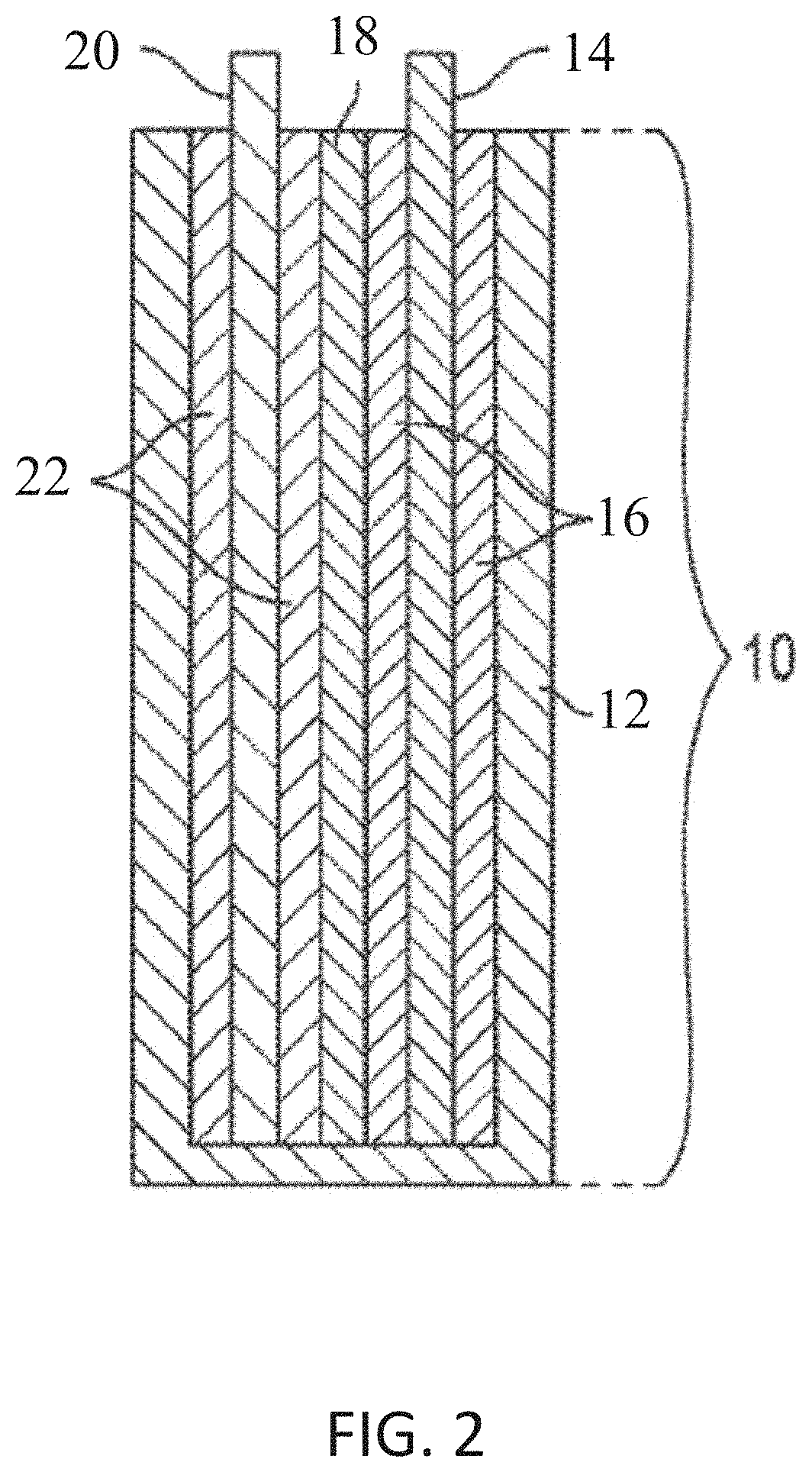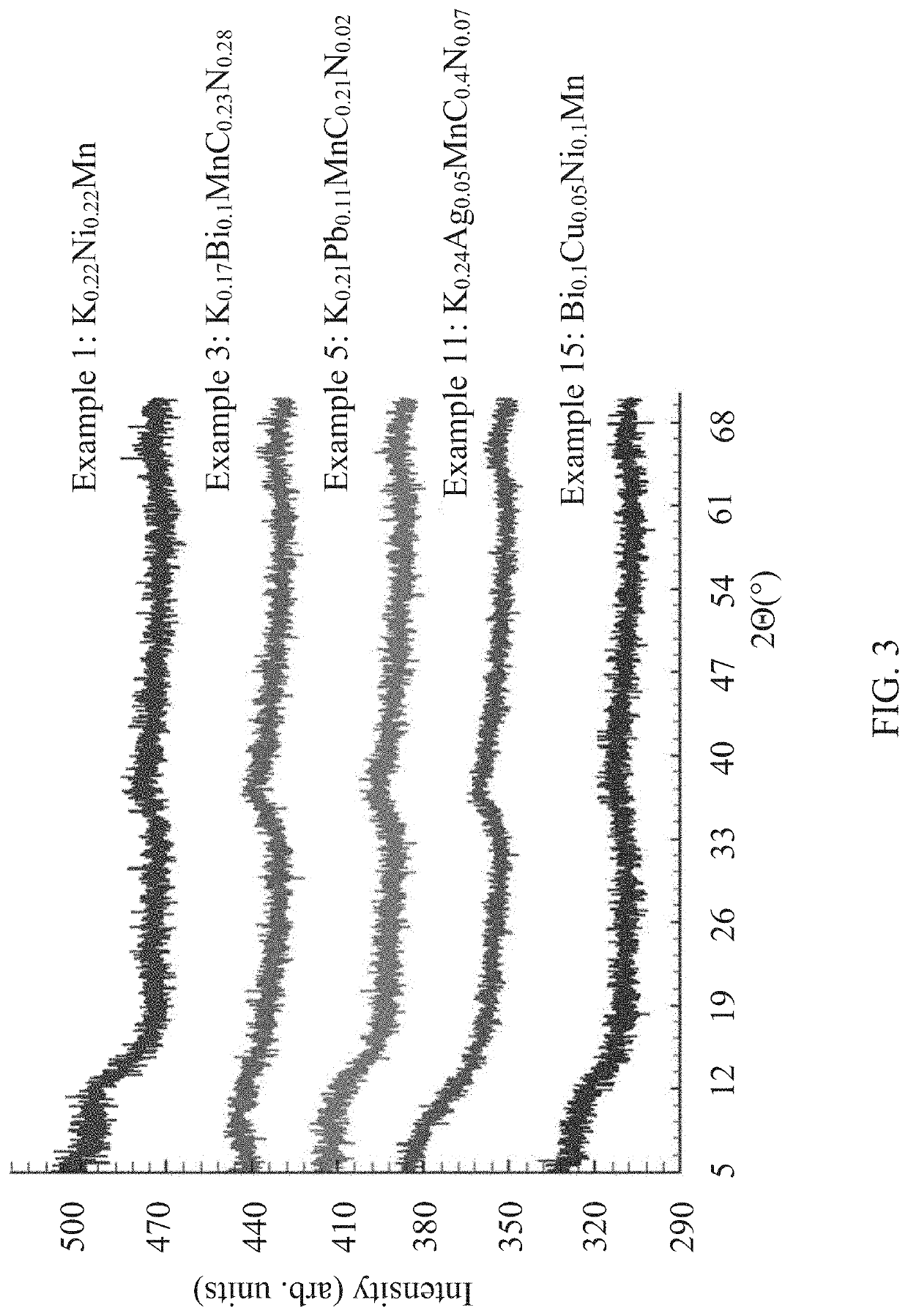Mixed metal manganese oxide material
a manganese oxide and metal technology, applied in the field of electrical energy storage, can solve the problems of inability to meet the needs of use, cost, durability, etc., and achieve the effect of low toxicity
- Summary
- Abstract
- Description
- Claims
- Application Information
AI Technical Summary
Benefits of technology
Problems solved by technology
Method used
Image
Examples
example 1
[0054]A solution was prepared in a 1 liter Teflon™ bottle by dissolving Ni(NO3)2*6H2O (0.02 moles, 5.81 g) in DI water (0.55 moles, 10 grams), followed by the addition of KMnO4 (0.1 moles, 15.80 g) and (NH4)2CO3 (0.078 moles, 7.5 g). All reactants were mixed together before the bottle was heated at 65° C. for 16 hours with intermittent venting during the digestion. The obtained slurry was then filtered and washed with DI water (3×100 ml) after which the material was dried at 100° C. Elemental analysis of the final product determined the composition to be K0.22Ni0.22Mn. The x-ray powder diffraction pattern of the product is an essentially amorphous x-ray powder diffraction pattern, showing no Bragg reflections with an I / I0>1, and only peaks with an I / I0 less than 0.1 in a range of 54 to 59 2Θ, as shown in FIG. 3.
example 2
[0055]A solution was prepared in a 1 liter Teflon™ bottle by dissolving NH4VO3 (0.02 moles, 2.34 g) in DI water (0.55 moles, 10 grams) and concentrated NH4OH (2.8 g, 0.024 moles) followed by the addition of KMnO4 (1 moles, 15.80 g) and (NH4)2CO3 (0.078 moles, 7.5 g). All reactants were mixed together before the bottle was heated at 75° C. for 16 hours with intermittent venting during the digestion. The obtained slurry was then filtered and washed with DI water (3×100 ml) after which the material was dried at 100° C. Elemental analysis of the final product determined the composition to be K0.31V0.18MnN0.16. The x-ray powder diffraction pattern of the phase matches the pattern shown in FIG. 3, showing no Bragg reflections with an I / I0>1, and only peaks with an I / I0 less than 0.1 in a range of 54 to 59 2Θ.
example 3
[0056]A solution was prepared in a 1-L Teflon™ bottle by dissolving Bi(NO3)3*5H2O (0.01 moles, 4.85 grams) in (0.042 moles, 4 g) of HNO3. The mixture was heated at 70° C. for 10 minutes until there were no precipitates, after which, KMnO4 (0.1 mole, 15.80 g) followed by the addition of DI water (0.275 moles, 5 g) and (NH4)2CO3 (0.078 moles, 7.5 g). All reactants were mixed before the bottle was heated at 70° C. for 8 hours with intermittent venting during the digestion. The obtained slurry was then filtered and washed with DI water (3×100 ml) after which the material was dried at 100° C. Elemental analysis of the final product determined the composition to be K0.17Bi0.1MnC0.23N0.28. The x-ray powder diffraction pattern of the product is an essentially amorphous x-ray powder diffraction pattern, showing no Bragg reflections with an I / I0>1, and only peaks with an I / I0 less than 0.1 in a range of 54 to 59 2Θ, as shown in FIG. 3.
PUM
| Property | Measurement | Unit |
|---|---|---|
| voltage | aaaaa | aaaaa |
| charge | aaaaa | aaaaa |
| valence | aaaaa | aaaaa |
Abstract
Description
Claims
Application Information
 Login to View More
Login to View More - Generate Ideas
- Intellectual Property
- Life Sciences
- Materials
- Tech Scout
- Unparalleled Data Quality
- Higher Quality Content
- 60% Fewer Hallucinations
Browse by: Latest US Patents, China's latest patents, Technical Efficacy Thesaurus, Application Domain, Technology Topic, Popular Technical Reports.
© 2025 PatSnap. All rights reserved.Legal|Privacy policy|Modern Slavery Act Transparency Statement|Sitemap|About US| Contact US: help@patsnap.com



